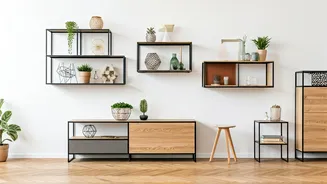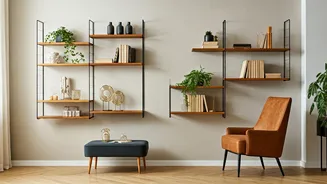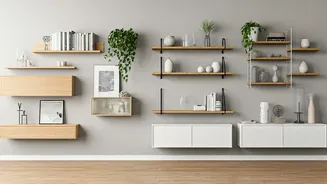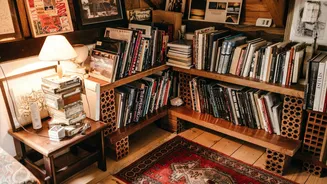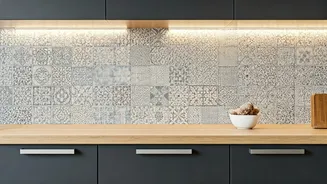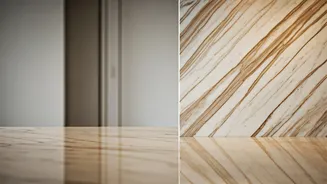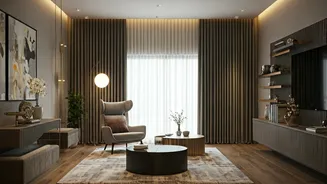Shelf Styles Explored
Wall shelves come in a diverse range of styles, each offering unique design possibilities. Floating shelves are popular for their minimalist and sleek
appearance, giving the illusion of items suspended in mid-air. These are ideal for showcasing art or creating a clean, uncluttered look. Corner shelves are a space-saving solution, effectively utilizing otherwise unused corners to provide extra storage or display areas. Ladder shelves offer a blend of storage and display, with shelves that gradually increase in size as they ascend, making them perfect for books, plants, or decorative items. Finally, cube shelves provide a versatile modular option, allowing for customized arrangements to suit various needs and preferences. Each style of wall shelf offers unique advantages and contributes differently to the overall design of a living space, allowing homeowners to choose the option that best fits their aesthetic and practical requirements.
Choosing the Right Shelves
Selecting the right wall shelves involves considering several key factors to ensure they complement your space and meet your needs. Assess the available wall space, taking into account both the area and the structural integrity of the walls. Choose materials that align with your style and the room's decor, such as wood for a warm and traditional feel, metal for a modern look, or glass for an airy ambiance. Evaluate the load-bearing capacity of the shelves based on what you plan to store on them, ensuring they can safely support the weight. Consider the color and finish of the shelves, aiming for harmony with existing furniture and decor or using them as a contrasting accent. Functionality is also critical: think about the intended use of the shelves – whether for books, decorative items, or storage – and choose accordingly. The combination of these factors ensures that the selected shelves are both visually appealing and practical for the intended use.
Placement and Styling Tips
Strategically placing and styling your wall shelves can significantly elevate your home decor. Height placement is crucial; position shelves at eye level for easy access and visual balance, and consider the proportions of the wall space. Grouping shelves creatively can create visual interest, whether arranging them symmetrically for a balanced look or asymmetrically for a more dynamic effect. When styling, vary the items on display to create visual diversity, incorporating a mix of sizes, shapes, and textures to prevent a monotonous appearance. Consider the principles of balance and visual weight; distribute heavier items towards the bottom shelves and lighter ones higher up to create stability. Theming the shelf decor around a specific color palette or style can unify the space and enhance the aesthetic cohesiveness. Finally, incorporate practical items like storage boxes or baskets to balance aesthetics with functionality and maintain a clutter-free look.
Shelves in Different Rooms
Wall shelves are versatile and functional in various rooms throughout the home. In living rooms, they are ideal for displaying books, art, and decorative items, enhancing the room's aesthetic appeal while providing accessible storage. In bedrooms, they can serve as bedside tables, bookshelves, or display areas for personal items and decor. Kitchens can benefit from wall shelves by using them to store spices, cookbooks, and kitchen essentials, adding functionality and style. In bathrooms, shelves provide space for toiletries, towels, and decorative items, helping to organize the space while adding a touch of elegance. Even in entryways, shelves can serve as a place to keep keys, mail, and other everyday essentials, creating a welcoming and organized first impression. Adaptability makes wall shelves a valuable addition to every area of a home, increasing both organization and design appeal.
Shelving Material Considerations
The material of wall shelves plays a key role in their appearance, durability, and suitability for different environments. Wood shelves provide warmth and classic appeal, available in various finishes and types, from solid hardwoods to engineered wood. Metal shelves, often in steel or aluminum, are ideal for modern and industrial settings due to their strength and sleek appearance. Glass shelves add a touch of elegance and transparency, creating an open and airy feel, though they require careful handling. Consider the moisture resistance of the material, especially in bathrooms and kitchens. The ease of maintenance varies between materials; wood often requires regular dusting and occasional polishing, while metal can be wiped clean easily. Also, the weight capacity of the materials differs, so ensure the shelf material can hold the intended items safely. Choose a material that not only complements the interior design but also meets the functional and durability requirements of its placement.
Installation and Safety
Proper installation is essential for both the aesthetic appeal and the safety of wall shelves. Before installation, locate wall studs using a stud finder to ensure secure mounting. Using wall anchors or screws that are appropriate for the wall type is crucial; drywall requires specific anchors, while concrete or brick walls need different fixtures. Measure carefully, use a level to ensure the shelves are straight, and drill pilot holes to guide the screws. When mounting, follow the manufacturer's instructions to ensure proper load distribution and avoid overloading the shelves, keeping in mind the weight capacity. After installation, inspect the shelves regularly for stability and any signs of wear and tear, tightening screws if necessary. For added safety, consider using shelf supports or brackets, especially for heavier items or when the shelves are subjected to frequent use. Safe and correct installation is essential for enjoying your wall shelves for years and keeping your home and possessions safe.


